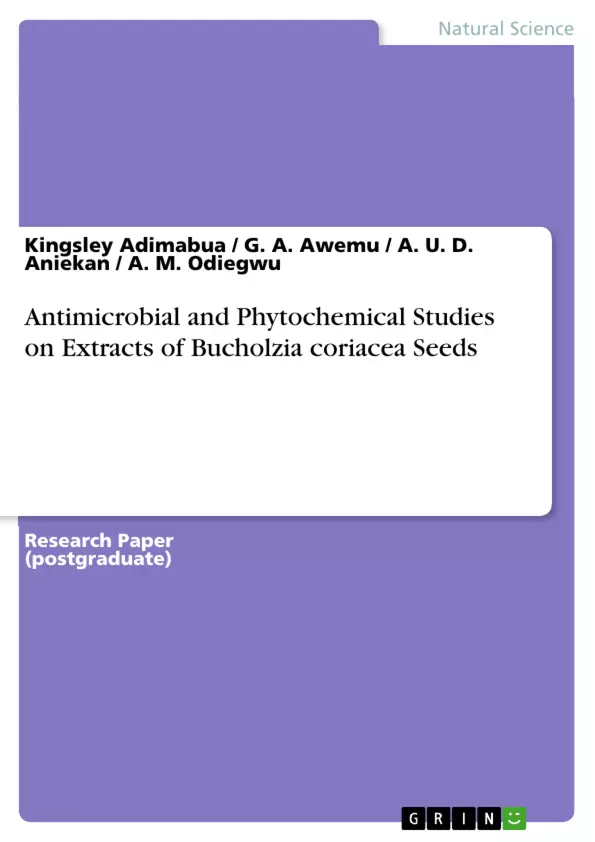The in vitro antimicrobial activity of crude methanol and aqueous extracts of the seeds of Bucholzia coriacea were investigated. The extracts exhibited antimicrobial activities against Escherichia coli, klebsiella pneumonia, Bacillus subtilis, Staphylococcus aureus, Salmonella typhii, Bacillus cereus and Pseudomonas aeruginosa. The minimum inhibitory concentration (MIC) of the ethanol extract was between 0.50 – 6.00 mgml-1 while the minimum bactericidal concentration ranged from 2.0 – 10.0. The methanol and water extracts exhibited antifungal activity against Candida albicans and Aspergillus niger with zones of inhibition of 7.50 and 2.80mm for Candida albicans; and 6.0 and 2.0 for Aspergillus niger. Phytochemical screening revealed the presence of tannins, saponins, terpenoids, cardiac glycosides and alkaloids in the ethanolic and water extracts. The ability of the ethanol extract of Bucholzia coriacea seeds to inhibit the growth of bacteria and fungi is an indication of its broad spectrum antimicrobial potential which justifies its utilization in traditional medicine in treatment of infections.
Inhaltsverzeichnis (Table of Contents)
- Abstract
- Introduction
- MATERIALS AND METHODS
- PLANT MATERIAL AND EXTRACTION
- PHYTOCHEMICAL TESTS
- MICROORGANISMS
- ANTIBACTERIAL ACTIVITY
- Anti fungal activity
- Minimum inhibitory concentration (MIC)
- Minimum bactericidal concentration (MBC)
- Results and discussion
Zielsetzung und Themenschwerpunkte (Objectives and Key Themes)
This study aims to evaluate the antimicrobial properties and phytochemical profile of extracts from the seeds of Bucholzia coriacea, a plant used in traditional medicine.
- Antimicrobial activity of Bucholzia coriacea seed extracts against various bacteria and fungi
- Phytochemical analysis of the seed extracts to identify potential bioactive compounds
- Comparison of the antimicrobial potency of methanol and water extracts
- Evaluation of the potential for Bucholzia coriacea as a source of new antimicrobial agents
- Justification of the traditional use of Bucholzia coriacea for treating infections
Zusammenfassung der Kapitel (Chapter Summaries)
The study begins with an introduction outlining the significance of finding new antimicrobial agents due to the increasing problem of drug resistance. It then details the plant material used, extraction methods, and phytochemical tests conducted. The antimicrobial activity of the extracts is investigated against various bacteria and fungi using standard methods, including agar well diffusion and broth dilution techniques. The results of the study are then discussed, highlighting the presence of various bioactive compounds in the extracts and the potential of Bucholzia coriacea as a source of new antimicrobial agents.
Schlüsselwörter (Keywords)
Bucholzia coriacea, antimicrobial activity, phytochemicals, ethnomedicine, drug resistance, bacteria, fungi, methanol extract, aqueous extract, minimum inhibitory concentration (MIC), minimum bactericidal concentration (MBC)
- Arbeit zitieren
- Kingsley Adimabua (Autor:in), G. A. Awemu (Autor:in), A. U. D. Aniekan (Autor:in), A. M. Odiegwu (Autor:in), 2013, Antimicrobial and Phytochemical Studies on Extracts of Bucholzia coriacea Seeds, München, GRIN Verlag, https://www.hausarbeiten.de/document/207815


